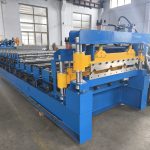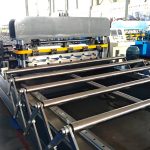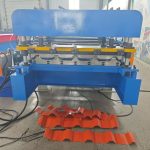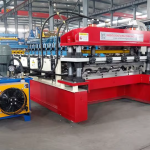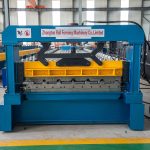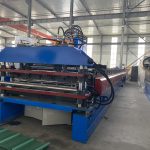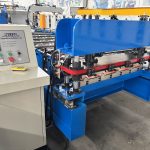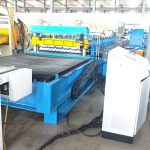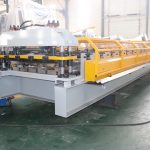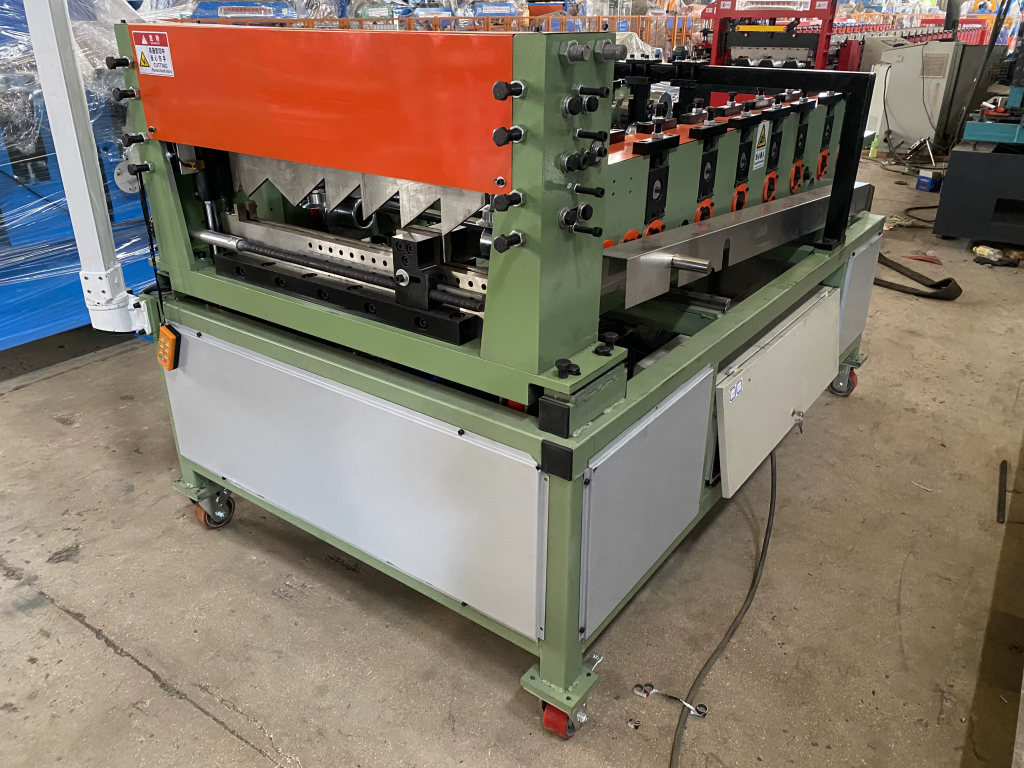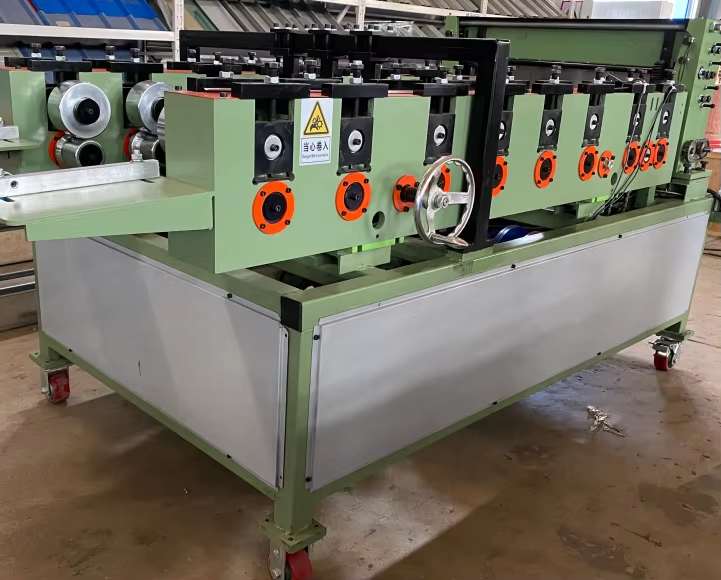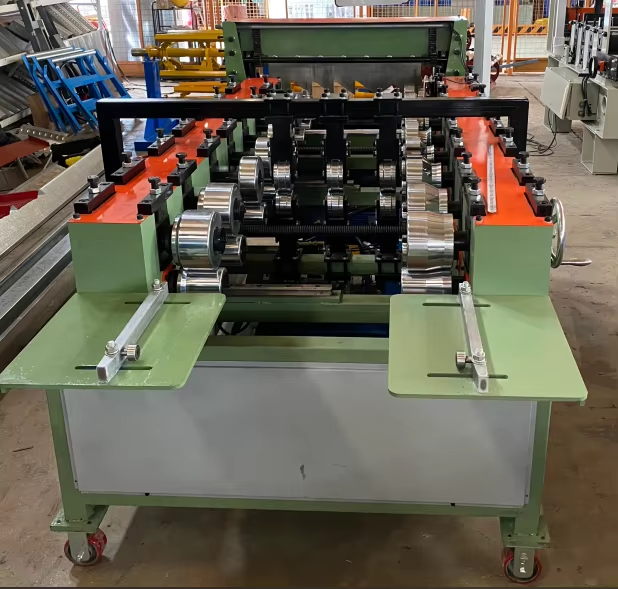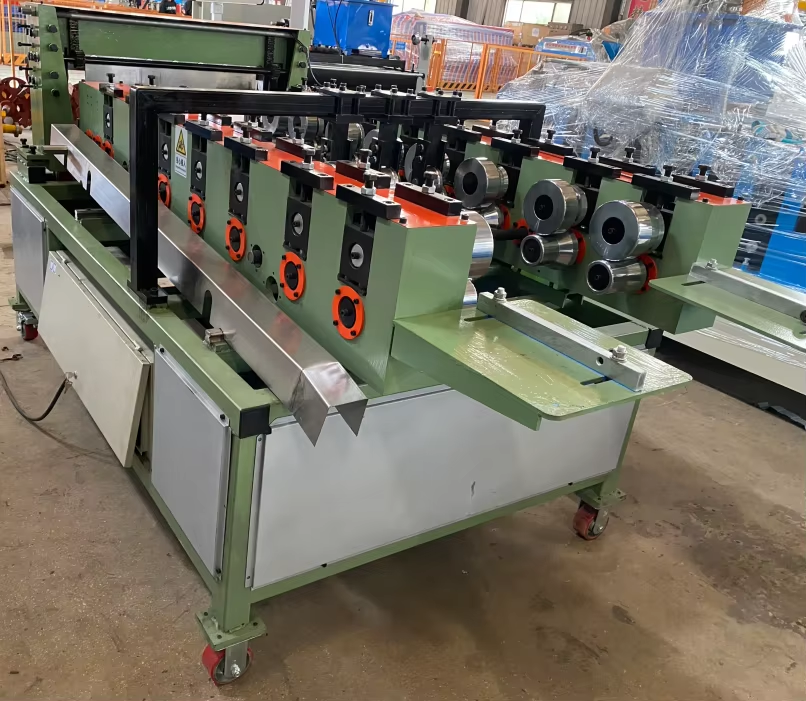Portable Vertical Seam Roof Panel Roll Forming Machine Metal Roof Machine
In the current trend of lightweight, efficient, and customized transformation in the construction industry, roof systems, as the core component of building appearance and function, have put forward higher requirements for the flexibility and precision of construction equipment. The portable vertical seam roof panel equipment, with its core advantages of “ready to use and on-demand production”, breaks the time and space limitations of traditional roof panel production and construction, becoming the preferred equipment for industrial plants, public buildings, villas, residential and other scenarios, redefining the efficiency and quality standards of roof construction.
Equipment core structure and workflow: Small volume contains large energy:
Although the portable vertical seam roof panel equipment is labeled as “portable”, its structural design and production capacity are uncompromising. It can be divided into four core modules: feeding system, forming system, shearing system, and control system. Each link works together to achieve integrated production from coil raw materials to finished roof panels.
1. Lightweight body design: the core support for portability
The entire equipment is made of high-strength aluminum alloy and cold-rolled steel plate composite material, with a weight generally controlled between 500-800kg. Some small models can even be disassembled into 3-4 independent units, with each unit weighing no more than 200kg. Only 2-3 people are needed to complete on-site handling and assembly. The bottom of the fuselage is equipped with universal wheels and adjustable support feet, which can move flexibly on flat ground and quickly fix in complex working conditions such as roof slopes, adapting to the site requirements of different construction environments.
2. Core system: Accurate and efficient production support
Feeding system: Adopting dual guide rollers and tension adjustment device, it can adapt to various coil materials such as 0.3-0.8mm thick color coated steel plates, aluminum magnesium manganese alloy plates, etc. The feeding width can be adjusted from 300-600mm, and the material offset is corrected in real time by photoelectric positioning sensors to ensure that the feeding accuracy is controlled within ± 0.5mm, avoiding forming deviation from the source.
Forming system: Equipped with 12-16 sets of progressive forming rollers, the rollers are made of Cr12MoV mold steel, processed by heat treatment, and surface plated with hard chromium, with a hardness of HRC58-62 and extremely strong wear resistance. The molding process follows the principle of “gradual bending, one-time molding”, and can produce various types of vertical seam roof panels such as upright lock edge, concealed buckle, and bite type. The panel height supports quick switching of commonly used specifications such as 25mm, 32mm, and 40mm, meeting different roof waterproofing and load-bearing requirements.
Shear system: equipped with a hydraulic driven shear device, the cutting blade adopts integral forging technology, and the cutting thickness can reach 1.0mm. The incision is flat and free of burrs, avoiding the deformation problem of the plate edge caused by traditional cutting methods. The cutting length can be preset through the control system, with an accuracy error of ≤ 1mm. It supports both single cutting and continuous batch cutting modes, adapting to different construction progress requirements.
Control system: Equipped with a 7-inch touch screen display and built-in visual operation interface, it can display real-time data such as production speed, produced length, and board parameters, and supports one click saving and calling of parameters. The equipment is equipped with an intelligent fault diagnosis system. When there is a shortage of raw materials, abnormal pressure and other problems, it will automatically shut down and pop up a fault prompt, reducing the difficulty of operation and maintenance costs.
3. Workflow: Three simple steps to achieve on-site production
Equipment debugging: After assembling the equipment on site, input parameters such as the length, width, and height of the roof panel into the control system according to the design drawings, debug the forming roller and cutting device to ensure parameter matching;
Raw material feeding: Fix the coil raw materials on the feeding rack, introduce them into the forming system through guide rollers, and after starting the equipment, the raw materials are gradually bent and formed under the action of the forming rollers;
Finished product output: The formed roof panels are cut to a predetermined length by a cutting device and directly transported to the installation position on the roof, achieving “production installation” and reducing intermediate transportation links.
Core advantage: Solving pain points and difficulties in traditional roof construction:
Compared to the traditional “factory prefabrication+on-site transportation” roof panel construction mode, portable vertical seam roof panel equipment has demonstrated significant advantages in four dimensions: efficiency, cost, quality, and flexibility, becoming a “efficiency revolutionary” in the field of roof construction.
1. Breaking the limitations of time and space, significantly improving construction efficiency
In the traditional mode, roof panels need to be transported to the site after being produced in the factory. Due to limitations such as the height of transportation vehicles and road width, it is difficult to transport ultra long and ultra wide roof panels, and problems such as panel deformation and surface scratches are prone to occur during transportation. The portable vertical seam roof panel equipment can be directly produced on the construction site without long-distance transportation, with a production speed of 8-12 meters per minute. It can produce 1000-1500 square meters of roof panels per day, which is more than 30% more efficient than traditional construction methods. For projects with tight schedules, equipment can be installed while producing, reducing construction waiting time and shortening the overall project duration.
2. Reduce overall costs and increase project profit margins
From a cost perspective, portable vertical seam roof panel equipment can reduce expenses in three aspects:
Transportation cost: On site production does not require the transportation of roof panels, saving transportation and packaging costs. Especially for remote or mountainous projects, cost savings are more significant;
Material loss: In the traditional mode, the loss rate during transportation and hoisting of roof panels is about 3% -5%. However, on-site production can accurately control the length according to actual installation needs, and the loss rate can be reduced to below 1%, greatly reducing material waste;
Labor cost: Equipment operation can be completed by only 1-2 people, which is more than 50% lower than the traditional mode that requires multiple people to cooperate in lifting and handling.
3. Ensure construction quality and improve the reliability of the roof system
The waterproof performance and structural stability of vertical seam roof panels depend on the accuracy of the panel shape and the quality of the bite. The portable vertical seam roof panel equipment ensures consistent bending angle and bite depth of the roof panel through progressive molding technology, avoiding deformation problems caused by storage and transportation during the factory prefabrication process. At the same time, the roof panels produced on site can be directly connected to the roof purlins, reducing the damage to the panel shape caused by intermediate links and improving the overall sealing and anti stripping performance of the roof system. In addition, the equipment supports the processing of multiple materials, such as aluminum magnesium manganese alloy plates with excellent corrosion resistance, and color coated steel plates with good decorative properties. Suitable materials can be selected according to project requirements to ensure the long-term performance of the roof.
4. Flexibly adapt to different scenarios to meet diverse construction needs
The portability and adjustability of the device enable it to adapt to different types of building scenarios:
For areas such as high-altitude roofs and narrow spaces that are difficult for traditional equipment to access, the equipment can be disassembled and transported to the roof site for assembly without the need for large lifting equipment;
Support quick switching between multiple board types and specifications. If there are roof requirements with different slopes and areas in the same project, multi specification production can be achieved by adjusting equipment parameters without the need to replace equipment;
The equipment is powered by a three-phase 380V power supply and can also be adapted to a generator for power supply. It can still operate normally for outdoor projects without a stable power grid, such as temporary factories and supporting buildings in scenic areas.
Widely applicable scenarios: covering multiple fields of building needs:
With its flexible performance and efficient production capacity, portable vertical seam roof panel equipment has been widely used in three major fields: industrial buildings, public buildings, and civil buildings, becoming the preferred equipment for roof construction in different scenarios.
1. Industrial buildings:adapted to the large-span requirements of factories and warehouses
Industrial plants, warehouses and other buildings usually have the characteristics of large spans and wide roof areas, requiring high load-bearing capacity and waterproof performance of roof panels. The portable vertical seam roof panel equipment can produce 0.5-0.8mm thick color coated steel plate roof panels. The plate type adopts the vertical lock edge design, and the bite depth can reach more than 30mm, which can effectively resist strong wind, rainstorm and other bad weather and avoid roof leakage. At the same time, the equipment can produce roof panels with a length of 6-12 meters according to the span requirements of the factory building, reducing the number of roof joints and lowering the risk of leakage. For example, in a steel structure factory project, equipment can directly produce roof panels at the top of the factory, which can be lifted by cranes to achieve efficient construction and meet the demand for “rapid production” of industrial projects.
2. Public buildings: balancing the dual needs of aesthetics and functionality
Public buildings such as sports arenas, convention centers, and airport terminals not only require roofs to have good functionality, but also need to consider the aesthetic appearance of the building. The portable vertical seam roof panel equipment can process aluminum magnesium manganese alloy plates, which have the characteristics of lightweight, corrosion resistance, and rich color. It can produce irregular shaped roof panels such as curved and fan-shaped, suitable for the complex roof shapes of public buildings. For example, in the sports arena project, the equipment can adjust the forming roller angle according to the roof curvature parameters to produce roof panels that perfectly fit the roof curve, ensuring the sealing of the roof and enhancing the overall visual effect of the building. In addition, aluminum magnesium manganese alloy roof panels have good thermal conductivity and can be used in conjunction with roof insulation layers to achieve energy-saving effects, meeting the green energy-saving requirements of public buildings.
3. Civil buildings: meet the personalized needs of villas and residences
With the development of prefabricated buildings, the demand for personalized and customized roof systems in villas and high-end residences is increasing. The portable vertical seam roof panel equipment can produce roof panels in various colors and board types, such as the concealed button vertical seam roof panel, which has a simple and elegant appearance and is suitable for modern style villas; The interlocking vertical seam roof panel has smooth lines and is suitable for European, American and other residential styles. The equipment can be produced on residential construction sites to avoid the occupation of community roads by the transportation of large roof panels and reduce the impact of construction on surrounding residents. At the same time, the roof panels produced on site can be precisely adjusted in length and shape according to details such as the slope transition and skylight position of residential roofs, improving the accuracy of roof installation and ensuring the long-term waterproof performance of residential roofs.


